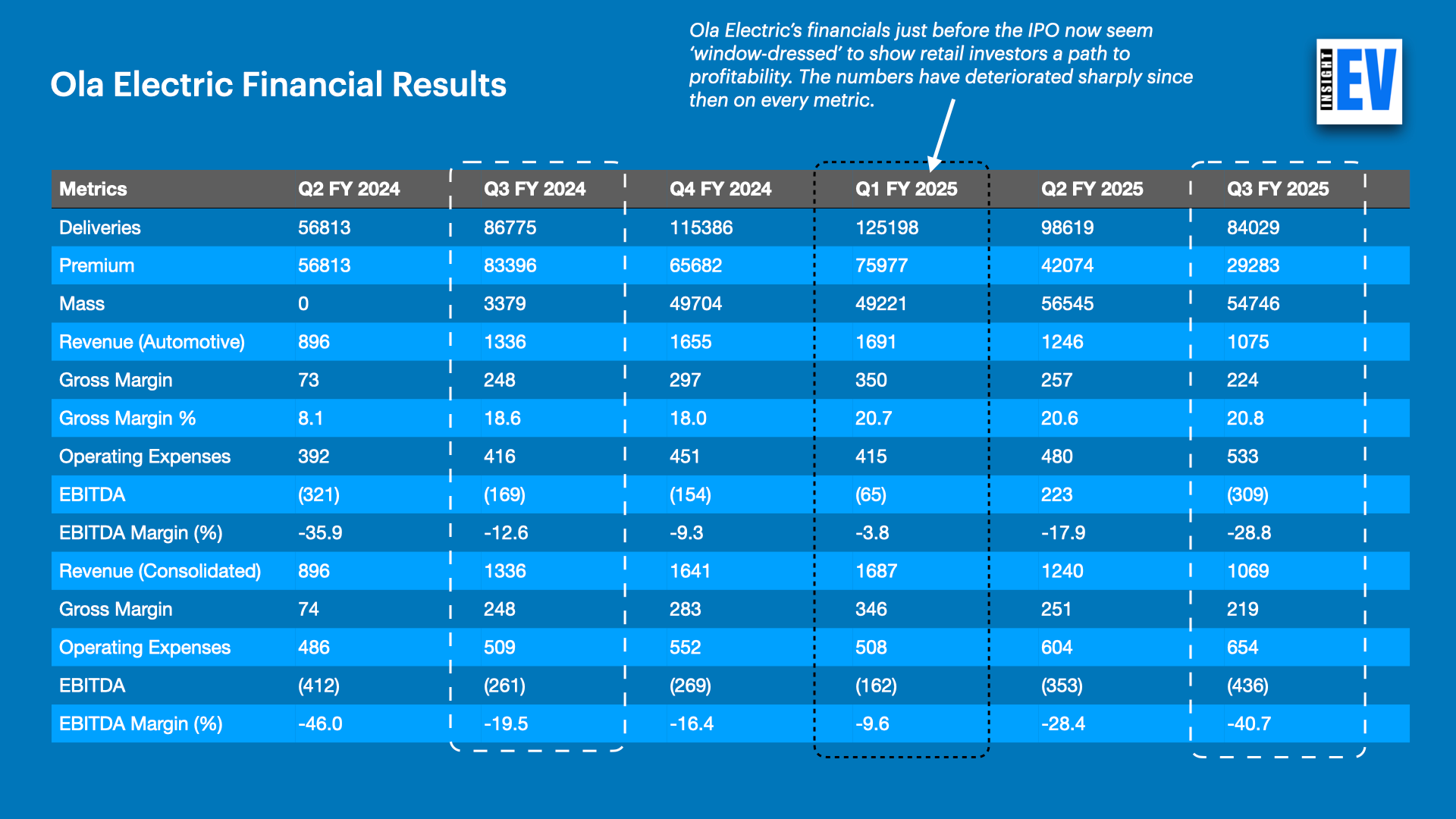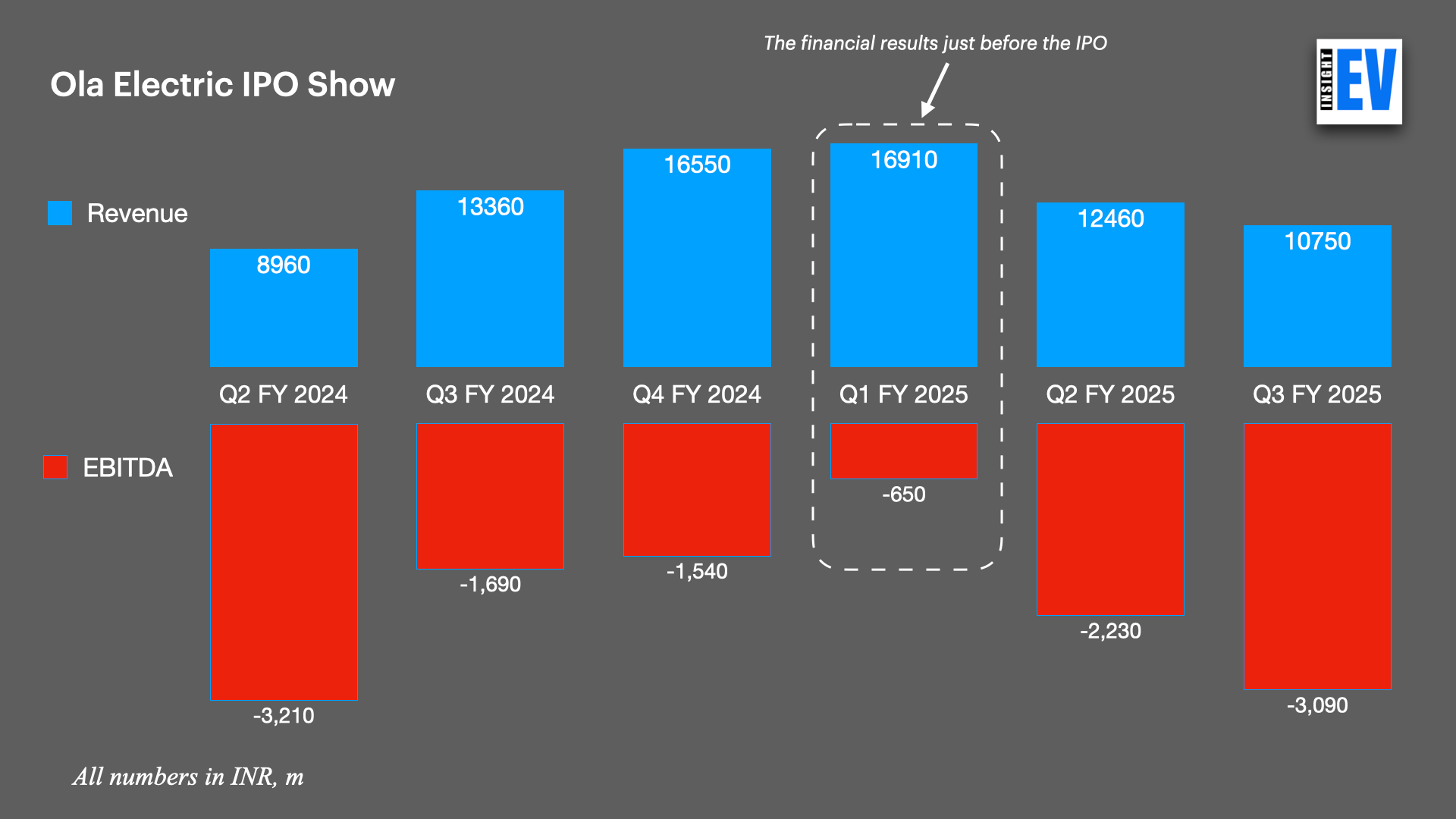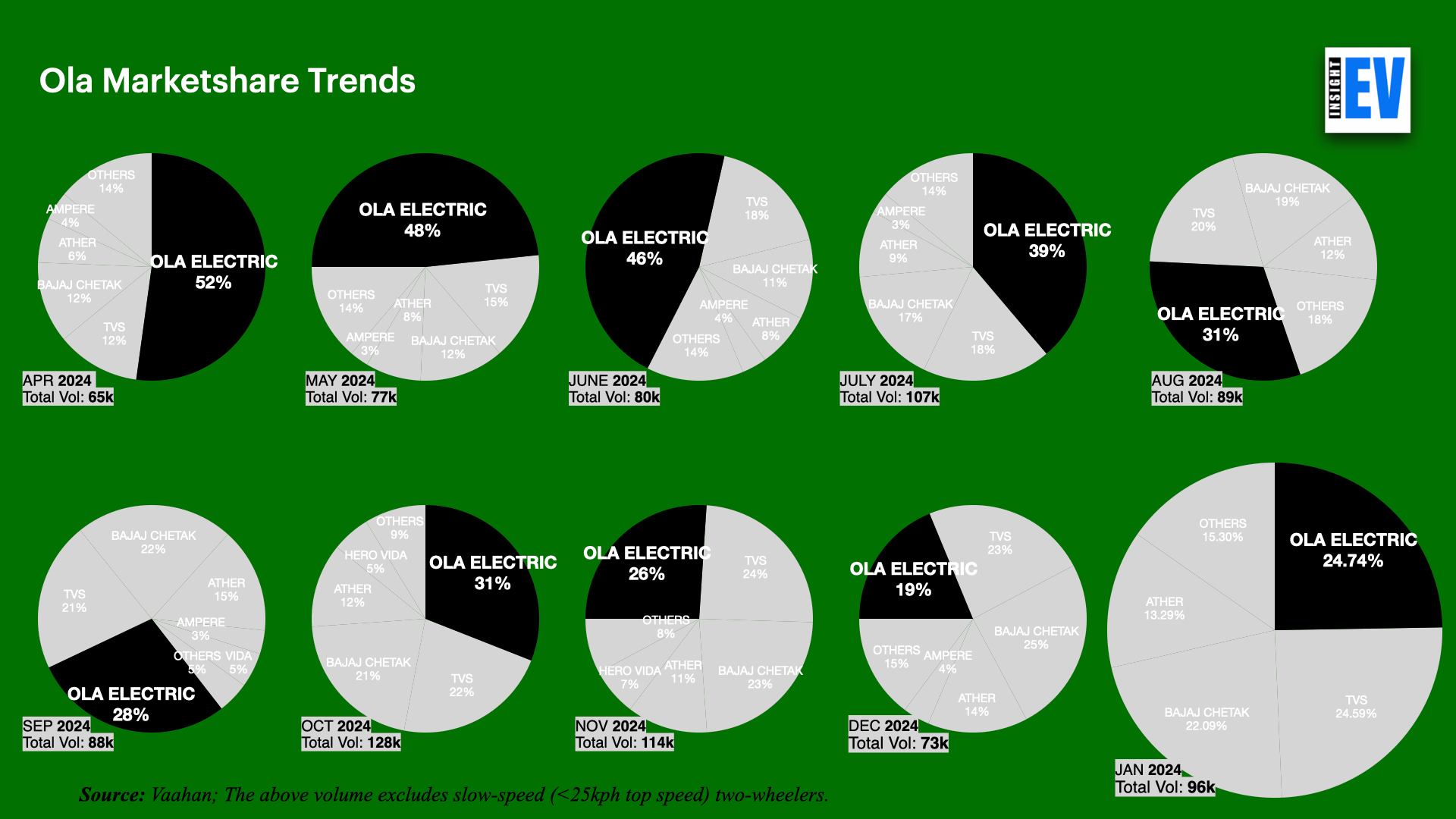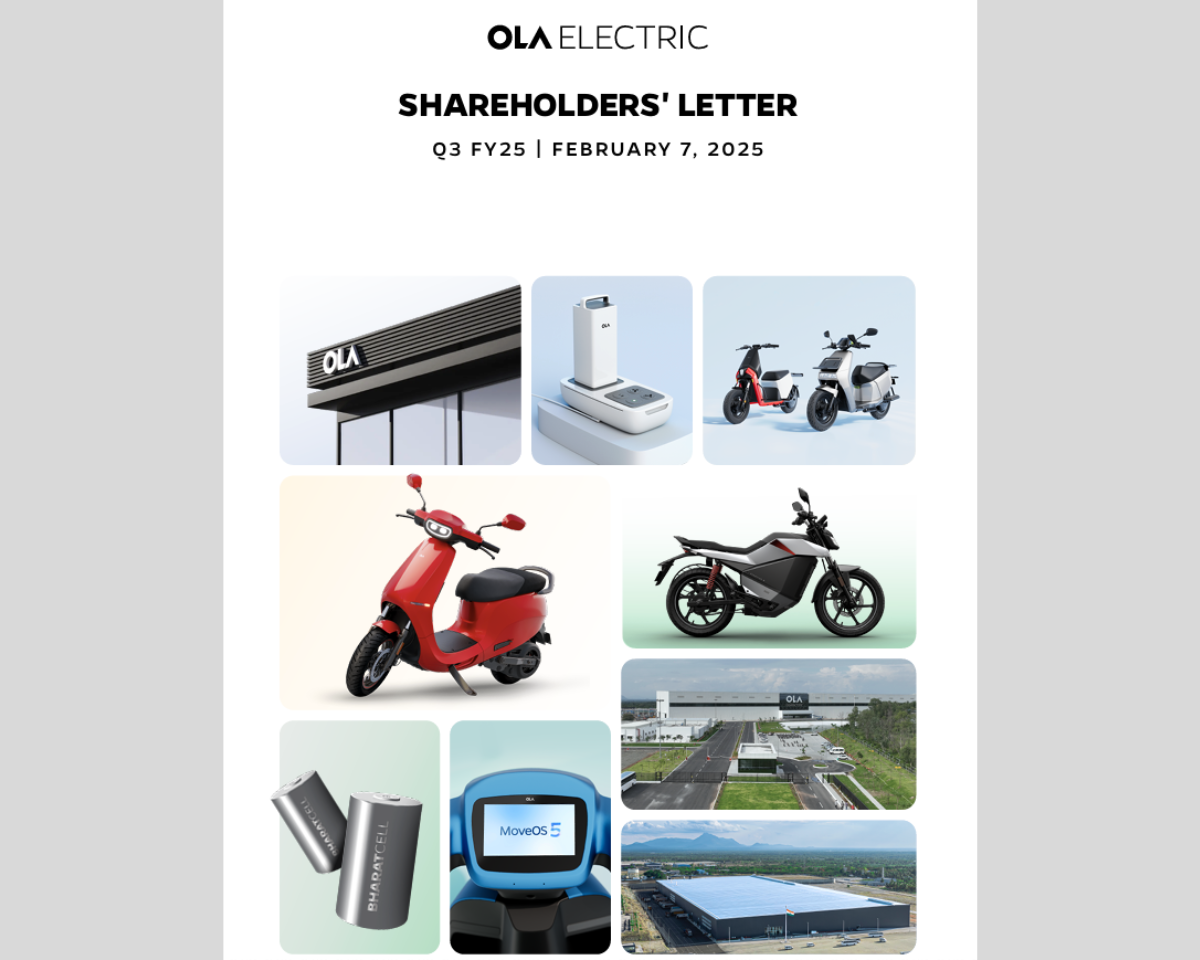The Key Metrics
Ola delivered 84,029 units in Q3 FY 2025, a 3.2% drop from 86,775 units in Q3 FY 2024. Within the same time frame, the industry grew 37.5% from 242,209 units to 333,063 units.
The company reported INR 10.75bn (USD 122.81m) in revenue, a 19.5% drop from INR 13.36bn (USD 152.63m) in Q3 FY 2024.
Ola claimed its gross margins were INR 2.24bn (USD 25.59m) in the quarter, compared to INR 2.48bn (USD 28.33m) in the previous year. At a percentage level, Gross margins improved to 20.8% from 18.6% in Q3 2024. Gross margins are defined as the difference between sales and input costs (BoM+Manufacturing).

That doesn’t mean much, as any manufacturer adds significant costs above that – sales, marketing, corporate, product development, etc. A better metric is EBITDA.
On an EBITDA basis, Ola doubled its losses to INR 3.09bn (USD 35.3m) from INR 1.54bn (USD 17.1m) in Q3 FY2024. This represents an EBITDA margin of -28.8%, a sharp deterioration from the EBITDA margin of -12.6% in Q3 FY 2024.
EBITDA was hit because the company incurred heavy expenses on the service front, warranty costs, rapid expansion of the distribution network, likely CAPEX, and product development costs for new products. Ola also incurred damages due to the heavy discounting that it has been doing to maintain its market share.
On the service front, where Ola had to ramp up to address product issues at a massive level, the company has incurred INR 1.1bn (USD 12.57m) as a one-time expense.
Ola Electric reports its financials at the automotive and gross level as it is investing heavily in setting up a cell gigafactory. At the gross level, Ola’s EBITDA margins were -40.7%, a 109% increase from gross EBITDA margins of -19.5% in the previous year.
Over the last two quarters (also the period post-IPO), Ola has steadily lost sales volumes, lost revenues, increased EBITDA losses, and increased loss margins.
Surprisingly, the company’s financial performance had peaked just before the IPO.
Ola Electric’s financials just before the IPO (Q1 FY 2024) now seem like ‘window-dressing’ to show retail investors a path to profitability and get an attractive valuation in the IPO. They were bad before that and have deteriorated sharply since then on every metric.

Loss in Market Share
The sharp decline in financial performance is unsurprising, considering Ola has been steadily losing market share.

Worse, market intelligence indicates that Ola discounts heavily to cling to market share, eventually compromising margins.
The Market is Shifting
With a significant increase in volumes, the Indian market is fast shifting towards low-cost, moderate-speed scooters. There is still a premium market, but Ather Energy has cornered it all, and Ola is increasingly getting pushed to the mass market. The lower end of the market is crowded and is fair play for everyone, from mass-market manufacturers like Ola Electric to small operators assembling scooters with IP from China. Much of the business is driven by fleet operators, and B2B sales are the core of the business.
That cannot be good for the brand or margins. In Q3 FY 2024, Ola reported that more than 96% of its sales were from the premium segment. In Q3 2025, this share has fallen to 34.8%.
We estimate that the average transaction price of an Ola scooter has fallen from INR 138,500 (USD 1582) in Q3 FY 2024 to INR 106,050 (USD 1211) in Q3 FY 2025.
The average transaction price would likely fall further as the company works on even cheaper products and heavy discounts.
The Problem with Retail Outlets
Unlike every other player in India, Ola has adopted a D2C sales model. The company owns all the stores. After its recent expansion spree, Ola Electric claims to have 4000 sales outlets nationwide. With sales falling to 25k units per month, this translates to a little more than six scooters sold per outlet. Since each outlet is a sales & service outlet, a minimum workforce of at least four people would be needed. That, plus the real estate and ancillary costs, would mean a large share of outlets would not be profitable. Ola would eventually close them down, and the much-touted network expansion would be undone.
Worse, Ola could cling to the outlets, incurring losses.
Other manufacturers do not face this problem as the dealers are responsible for setting up the sales and service, and maintaining the teams. Ola’s model incurs high upfront costs to save the 3% margins that the two-wheeler dealers in India typically earn. The D2C model may be great if Ola sold a few million scooters yearly at high transaction prices. This does not seem to be happening, and it is apparent that the company is increasingly losing sales volumes, along with a lowering of average transaction prices, further putting the business model under stress.
Misleading with Technology Claims
We have extensively covered the issue of Ola misrepresenting tech, claiming that its new scooter range has Brake-by-wire and dual-channel ABS.
In the shareholder’s letter issued today, Ola has repeated the claims.
Is the Product Rollout as per plan?
With its recently announced products – the new scooter portfolio and the Roadster X+ motorcycles- Ola has been optimistic about the top variants energized by the company’s 4680 cells. The S1 Pro+ 5.3kWh variant and the Roadster X+ 9.1 kWh variant have battery packs constructed with the 4680 cells.
However, cell production would not start till April 2026 at least. That means the batteries were not homologated, and the range claims were theoretical.
Share Price and Promoter Pledging
Ola’s share price closed at INR 69.97. The quarterly results were released after the market close.

The share has been steadily trading below the IPO price of INR 76. In early December, promoter Bhavish Agarwal pledged some of his holdings (representing 1.1% equity of the company) in Ola Electric. At that time, the share was trading around INR 99.
Apart from Ola Electric, Agarwal runs Ola Cabs (now renamed Ola Consumer) and Krutrim, a new startup in the area of cloud computing, AI, and chip design. Agarwal has been funding Krutrim’s expansion by pledging his Ola Electric shares.



